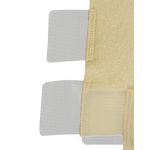Lymphedema Compression Wraps
Lymphedema Compression Wraps
A compression wrap is a "compression alternative" which provides a wider range of compression than other traditional compression garments. Easy to use, it provides steady and comfortable resting compression as well as higher working compression when the wearer is active.
Shop our lymphedema compression wraps with pre-tax savings using your FSA or HSA account!
Lymphedema Compression Wraps
A compression wrap is usually worn after completion of complete decongestive therapy, or "CDT", and during the secondary or "maintenance" phase of Lymphedema treatment.
A wide array of compression devices have been designed to accommodate the body's anatomical structure to include compression wraps for hands, compression wraps for arms, and compression wraps for legs and feet.
A compression wrap may be an easy-to-apply alternative for patients who:
Lymphedema Compression Wraps For Legs
Compression wraps for legs offer an effective solution for managing swelling and improving circulation for lymphedema, edema, venous disorders, post-surgical recovery, and other medical conditions. Leg compression wraps are easy to adjust for changes in leg size due to fluid retention. Compression leg wraps can help reduce discomfort, prevent fluid accumulation, and promote overall leg health.
Lymphedema Compression Wraps For Arms
Compression wraps for arms are designed to apply uniform pressure, and they can treat and manage lymphedema, edema, venous disorders, circulatory conditions, and other medical conditions. Easy to put on, adjust, and take off, lymphedema arm wraps can accommodate fluctuations in arm size.
Lymphedema Compression Wraps For Hands
Compression gloves and gauntlets can help reduce swelling and improve circulation, and they are often used to treat lymphedema, post-surgical edema, and arthritis. Lymphedema gloves and gauntlets are specifically tailored to fit the unique contours of the hand and wrist. They provide targeted compression to encourage lymphatic drainage and reduce discomfort. Designed to promote dexterity and mobility, compression gloves and gauntlets can be easily adjusted for a comfortable, effective fit.
Lymphedema Compression Wraps For Feet
Compression wraps for feet can help alleviate the discomfort and swelling associated with conditions such as lymphedema, edema, venous insufficiency, and plantar fasciitis. Compression wraps provide targeted compression to the foot, enhancing blood and lymph circulation, which in turn helps to reduce edema and promote healing. Easy to put on and take off, feet compression wraps can be easily adjust to accommodate fluctuations in swelling.
You may also consider our RianCorp laser for lymphedema treatment (post-mastectomy) as an additional treatment alternative.
FAQs About Lymphedema Compression Wraps
Below are some of the most frequently asked questions about compression wraps for lymphedema.
Compression wraps for lymphedema are adjustable, bandage-like devices designed to provide a consistent level of compression to areas of the body that are affected by lymphedema (such as the legs, arms, hands, and feet). Unlike traditional bandages, lymphedema wraps typically feature Velcro closures, making them easier to apply, adjust, and remove.
Compression wraps help manage lymphedema by applying steady pressure to the affected area. This pressure supports the lymphatic system, by promoting the movement of lymph fluid out of the swollen area and by reducing fluid accumulation. The consistent compression provided by lymphedema wraps can also help prevent further swelling.
There are various types of lymphedema compression wraps available, designed to fit different parts of the body, such as the legs, arms, hands, and feet. Each type of lymphedema wrap is tailored to provide appropriate pressure and support for the specific area of the body that it is designed for. Lymphedema wraps also come in different sizes and levels of compression.
Like other forms of compression therapy, lymphedema wraps cannot cure lymphedema, which is a chronic condition. However, the compression wraps can help reduce symptoms, increase mobility, and improve quality of life.
By reducing swelling and supporting the area of the body that is affected by lymphedema, compression wraps can help alleviate discomfort and pain.
A properly applied lymphedema wrap should feel snug, but not painfully tight. The compression wrap should apply uniform pressure, without slipping or causing bulges. If you experience numbness, tingling, increased pain, or discoloration, your lymphedema wrap might be too tight and/or improperly applied.
Whether you can wear compression wraps while you sleep depends on your individual situation and should be guided by the advice of a healthcare provider. Generally, however, nighttime compression for lymphedema is managed differently than daytime compression, due to the different needs of the body during rest. During the day, movement helps stimulate lymph flow, and lymphedema compression wraps are designed to provide a balance between compression and flexibility to accommodate your daily activities. At night, your body is mostly at rest, and the need for compression changes. Specialized nighttime compression garments are often made of softer, more breathable materials and provide gentle, consistent pressure to support lymph flow while sleeping.
We carry most brands of lymphedema compression wraps, from some of the top manufacturers of lymphedema products including: FarrowWrap, Juzo, Circaid, Sigvaris, Medi USA, Solaris, and Therafirm.
Follow the manufacturer instructions for care and cleaning of your lymphedema wraps. Most compression wraps can be hand-washed in cool or lukewarm water with a mild detergent. Avoid using fabric softeners, as they can degrade the material of the compression wrap. Lymphedema wraps should be air-dried, away from direct heat or sunlight.
Typically, lymphedema wraps need to be replaced every 6 to 12 months, but the lifespan of a lymphedema compression wrap depends largely on how frequently you use it and how well you care for it. It is important that you regularly look for signs of wear on your lymphedema wrap (such as stretching, thinning fabric, or weakening of the Velcro).
Compression wraps for lymphedema offer a more customizable fit than standard compression garments, because they can easily be adjusted to accommodate fluctuations in swelling. Compression garments for lymphedema are typically used for maintaining limb size, while compression wraps are often used in the initial stages of lymphedema treatment, in order to reduce swelling more dynamically.
While both lymphedema compression wraps and short stretch compression bandages serve the same purpose of managing lymphedema, lymphedema wraps are generally considered easier to use because of their Velcro closures. This design makes them easier to put on, take off, and adjust.
For more information about our lymphedema compression wraps, please call (800) 700-1032, or e-mail info@bandagesplus.com.
••••••••••••••••••••••••••••••••••••Medicare Pays For Lymphedema Products
Please note: Thanks to the Lymphedema Treatment Act, which took effect on January 1, 2024, Medicare began to pay for lymphedema products for those who have Medicare B coverage and meet certain other coverage criteria. Please visit our website page covering the details of the Lymphedema Treatment Act to obtain more information about how Medicare pays for lymphedema garments, wraps, and bandages.





















